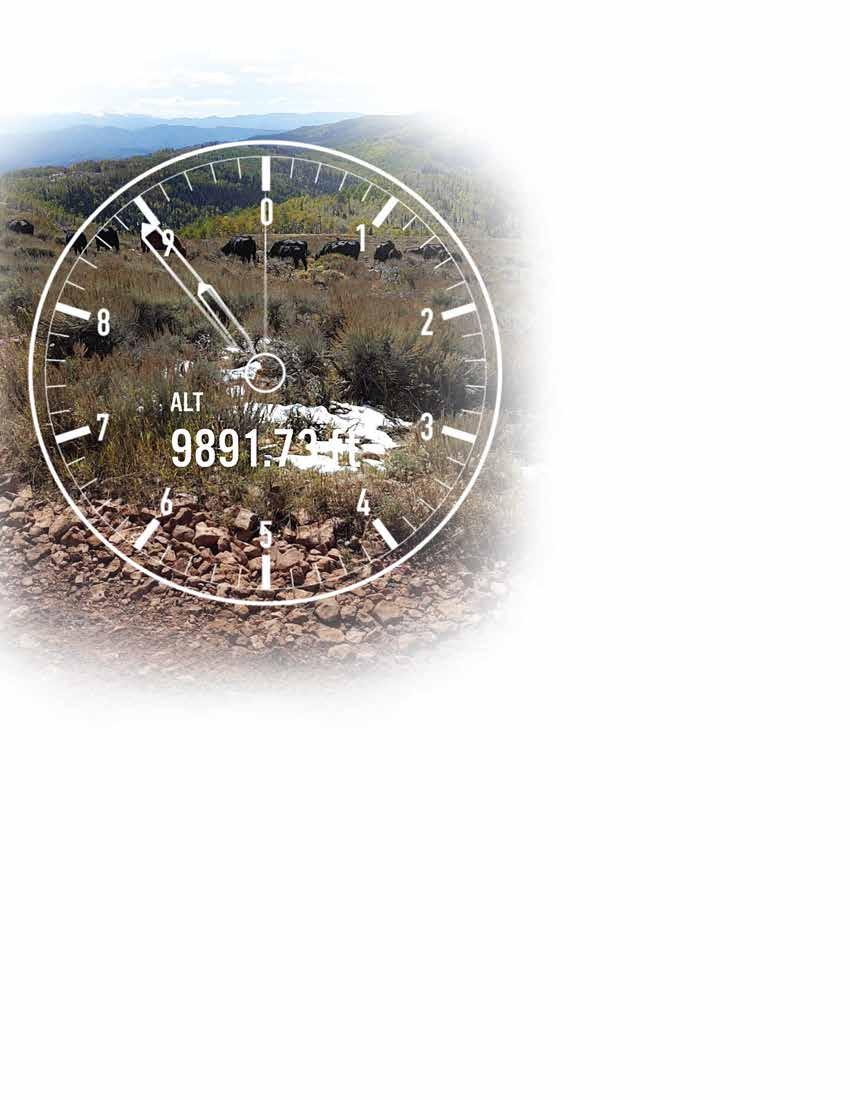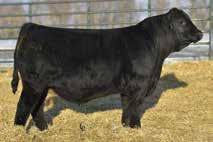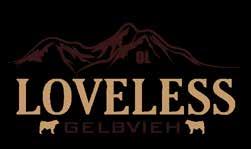
14 minute read
Bull development for commercial producers
BULL BUILDERS
The details of bull development and getting what you pay for
Advertisement
by Stevie Ipsen for the Utah Cattlemen’s Association
Though often reserved and kept to themselves, you’d be hard pressed to find someone more educated than today’s rancher. Not only are they inquisitive students of the industry, they are often more aware of the environment than a meteorologist, as adept at animal health protocols as some veterinarians, and are as reliable at predicting the success of a mating as many genetic formulas. Like any specialist, experience in their field – coupled by a willingness to adapt – is what determines their level of proficiency.
When it comes to raising breeding bulls, seedstock cattlemen are learned experts who don’t come by their knowledge easily. Unlike more ruthless industries, time and time again purebred beef producers share what they know to help other cattlemen and women prosper. For commercial cattlemen, their seedstock suppliers are one of the most important parts of their business.
As bull sale season lies directly before us, seedstock producers across the Intermountain West are gearing up for the finale event of a long list of preceding events. In fact, the most important aspects of a successful bull sale happen years, sometimes even decades before the culminating bull sale. From developing a reliable cowherd to learning the best way to feed high-performing herd bulls, the most intricate details of sale season are the parts no one ever sees.
For commercial cow-calf producers looking to invest in genetics this spring, Utah’s seedstock producers have a great deal to offer and you need look no further than your backyard to find a seedstock operator who is not only willing to help you find what you are looking for, he has already been hard at work doing just that long before this year’s bull offering hit the ground.
Eric Lyman of Lyman Livestock, based in Salem, Utah, said it takes years of building a functional cow herd to fit a specific environment. “It takes generation upon good generation of good mother cows mated to the right functional sires...then letting those genetics work in your environment,” Lyman said. “All of that happens long before this year’s calf hits the ground.”
In addition he says it takes countless hours pouring over A.I. stud catalogs, making calls to other breeders who have used similar genetics or run cattle in similar environments. Getting verbal feedback from customers – both repeat and potential new ones – is also important in knowing what producers want in a bull as well as in a seedstock producer is also a critical step, Lyman says.
Lyman emphasizes there is also the never-ending list of herd health protocols and management steps that have to be met to get a bull calf all the way to being a sire prospect. This includes everything from pre-breeding cow vaccines all the way to the breeding soundess exam and everything in between, he says.
Goals
A good bull development program has to include an attainable game plan. For some producers this may mean beginning by evaluating the resources they have available. Facilities, labor and land are just a few of the resources that have to be considered when it comes to raising and developing young bulls. A proper bull development program involves a lot of cost management and a welldesigned nutrition and herd health program – not to mention people who can be on hand to implement such a round-the-clock program. So capital is also a concern.
In addition to the physical goals needed on the operation itself, seedstock producers also need to know what they are aiming for in terms of the bulls they are seeking to produce. Some questions they likely as themselves on a routine basis are: Who am I raising bulls for? What are some consumer trends in the beef industry I need to be aware of? What does the commercial cattleman need? What will it take for me to develop bulls for him/ her?
Genetic Selection
Not only does raising a functional, broody cowherd take a lot of trial and error, but utilizing breed genetics and expected progeny differences (EPDs) that will appeal to bull customers is also important for a successful calf crop. Seedstock producers should start with careful evaluation and selection of sires that will complement the cow herd and are expected to produce a desired type of bull calf.
Lyman says his family also runs a large commercial herd which allows them the opportunity to see their genetics go to work.
“Bulls have to be able to travel and have the stamina to breed!” Lyman said. “Moderate frame, moderate milk, good growth, eye appeal and stayability have to be main characteristics of the mother cow.”
High elevation testing is something else Lyman says they consider to be paramount for their customers.
“We study out bulls that have been PAP-tested, progeny PAP-tested, and use the new PAP EPDs through Angus and Simmental Associations. We also only purchase PAP-tested clean up bulls for our registered herd. We want a fully functional cow that we can A.I. on first cycle, carry a value-added functional calf to weaning while traveling from VOLUME 7 • FEBRUARY 2021
BLM to forest permits and repeat year after year.”
Anymore, genetics can change your bull calves immensely from year to year so it is important for a purebred manger to do their homework before they ever order a single straw of semen or make a herdsire purchase.
For Jake Rees of Rees Bros., a Hereford seedstock business in Morgan, Utah, selecting genetics to implement in their herd and to sire bull calves, requires a good deal of caution because as Rees says regarding trends “newest” may not actually be an improvement.
For Rees Bros., soundness and fertility are crucial, in addition to paying attendtion to how a bull is raised and fed.
“There in no compromise for soundness, not only does it hurt your bottome line, but worse, it hurts or destroys your reputation,” Rees explains. “Marginal soundness in feet and leg struction always bites you in the end.”
Rees says with fertility being the No. 1 economic trait in beef production, scrotal development is one aspect he weighs heavily when considering genetics. Bulls with a higher scrotal circumfrence produce females that are more fertile.
In addition to traits Rees Bros. select for, there are also traits he says he is leery of - excessive body condition being one of those.
“Fat can help an animal look better than he really is,” Rees said. “Consideration should be given to how a bull is fed compared to your operation to determine if that will work in your environment.”
Culling
Not every male born on a seedstock operation will be the kind and quality needed to make it as a breeding bull. For this reason, seedstock producers should start taking note of a calf’s potential the day he hits the ground. From the size of the calf at birth to his markings, structure and the way he moves and eats, everything about a new calf catches the eye of a seedstock beef producer.
Nursing problems for bull calves may lead to problems that may result in culling. Early identification of these calves could necessitate castration.
Weaning is also a good time to cull low-performing, unthrifty, structurally unsound or genetically inferior bull calves and select those bull calves that will continue on in a breeder’s bull development program. Bulls are also evaluated throughout their development for temperament. For bulls that exhibit poor disposition, culling may be considered.
When it comes time to market bulls, those who are fast-gaining, structurally correct, free of genetic defects and easy to get along with are sure to fetch a better price tag. Culling bull calves is not the only aspect of culling that a good seedstock producer considers. Routine evaluation of a cowherd is also an important part of bull development as a quality bull is only as good as the factory he came from and he will pass on her genes as much as his sire’s.
Though culling isn’t any rancher’s favorite part of the job, it is one that pays them back in the long run.
It regards to selecting “keeper bulls,” Rees says he thinks it is quite simple. “We make steers out of any little, ugly ones regardless of pedigrees and the money it cost us to get them. If we wouldn’t use a bull on our own commercial cows, we know we won’t have anything to apologize for later.”
Nutrition
Postweaning development of beef bulls is imperative to their success as breeding bulls. It is also one of the more costly parts of being a purebred beef producer, making it one of the parts of bull development that separates mediocre breeders from the best ones. Different management is essential for bulls of different stages. Bulls are usually separated and managed according to age. For example, weanling bull calves, yearling bulls, gain-tested bulls, two-year-old bulls, mature bulls, etc., each demand a different ration in order to reach their full potential. Separating younger bulls from older ones may not be convenient but is vital for preventing injuries. Dividing bulls into specific categories also allows for easier for formulating rations at feeding time.
As bulls grow and mature, their feed requirements subsequently change. Younger bulls require less quantity, ...CONTINUED ON PAGE 16
higher quality diets. While daily dry matter intake typically increases with body weight, the protein requirement as a percentage of dry matter intake declines. Younger bulls require a higher percentage of protein for the rapid lean muscle growth that is occurring during early in their development.
USU Area Animal Scientist Kim Chapman says everyone knows that fat sells but getting bulls fat is not necessarily the best thing for the longevity of the bull.
“I sometimes hear commericial producers say, ‘He looked awfully good on sale day but I got him home and he fell apart.’ But the key thing about young bulls that commercial producers should remember is that these are growing bulls so they need to be cared for differently than mature bulls. They have a year or more of growth left and should be fed that way. Chapman said. “And by ‘fed’ I don’t mean pouring the grain to them either. Young bulls need forage and fiber to gain well but also so you won’t burn them up.”
Chapman also reminds that the USU extension service is available to offer ration formulation to ranchers.
Health
When considering vaccination protocols for breeding bulls, it is good to know which diseases can lead to reproductive problems. As Jake Reese pointed out, high reproductive efficiency is the most vital economic factor for success in a cow-calf operation. Diseases that can result in abortion, infertility and reproductive performance in the cowherd are obviously detrimental to reproductive efficiency. These kinds of disease include leptospirosis, Infectious Bovine Rhinotracheitis (IBR), Bovine Viral Diarrhea, vibriosis and trichomoniasis. Bulls should be vaccinated for these diseases prior to marketing.
Your local veterinarian has the most complete knowledge on diseases in your area and can make more specific recommen¬dations for developing a vaccination protocol for your specific herd. An individualized approach to disease risk and management is the most effective.
Breeding soundness evaluations (BSE) prior to marketing or breeding is one tool that helps ensure that only bulls with likelihood of successful breeding will be sold and used. Breeding soundness is very important in herds of all sizes, regardless of the number of bulls utilized in a cowherd. While few bulls are completely sterile, but have do generally have a fertility level that ranges from very high to very low. A BSE helps determine which bulls will not perform satisfactorily for potential culling from the herd.
According to Merck Animal Health, approximately one in five bulls will not pass a BSE. A breeding soundness evaluation performed by a veterinarian one or two months prior to the breeding season is an important management procedure. This involves a complete physical examination, a scrotal circumference measurement and a semen evaluation of the bull. Scrotal size is directly correlated with actual volume of sperm production. In addition to a BSE, observing the bull during service is necessary for monitoring cow cycling activity and ensuring that cows are being serviced timely and properly.
A BSE is not only in the best interest of the breeder, it is also essential to good customer service and a satisfied cow-calf producer.
Marketing
When it comes time to merchandise breeding bulls, seedstock producers can take a variety of steps to ensure an optimal audience of bull buyers. Whether marketing cattle online, private treaty or through a live auction, each seedstock producer should pursue the avenue that is best for them.
Factors that may be included in making this marketing decision are: Bull offering – how many bulls do you have to market? The more bulls you have, the more likely you are to need a larger audience and a big event. A smaller number of bulls may give you the ability to sell them private treaty or via an intimate online event. Facilities – do you have the means and ability to hold an live, in-person sale event? Budget – What kind of capital you have on hand may determine where and how often you can advertise your sale offering. Budget may also dictate if you can afford to entertain a sale audience, afford an auctioneer, etc. But if one thing is for certain in any business, including the cattle business: You have to spend money to make money. Cutting corners likely won’t glean the sale results you want.
Regardless of what kind of sale event you plan to have, if you want to access a wider base of potential buyers, advertising – whether online or through print marketing, or ideally through both – is extremely important to getting the best price for your bull offering.
Similarly to the factors impacting the decisions of seedstock producers, commercial cattlemen also have decisions to make when it comes time to buy bulls. It can be easy to get lost in all of the information that is available to commercial cattlemen, . If you are a commercial producer, how do you know what kind of bulls are available? How do you know where to look? How do you know exactly what you need? As a producer of any kind, exposing yourself to as much material as possible will give you access to a wide range of breeds, a variety of genetic trends and seedstock suppliers.
While print advertising in conventional journalism is becoming less of a necessity in today’s world, the beef industry still relies heavily on print advertising and marketing, coupled with digital advertising to appease certain portion of buyers.
Regardless of how a seedstock producer markets their bull offering or how a commercial cow-calf rancher chooses to buy bulls from year to year, one theme will generally continue to ring true: You get what you pay for. This theme applies to every facet of cattle marketing from what a purebred breeder is willing to pay for a straw of semen or quality vaccine or advertising your bull offering. This philosophy applies to commercial cattlemen as well. While the price for bulls has increased exponentially in the last decade, it is important to remember all that goes into producing a good bull and the dividends he will pay back when it comes time to sell his calf-crop.
Are your bulls used to 10,000 feet?
Ours were raised there


We raise our cattle like commercial cattle! We expect them to survive the rigid conditions year-round with minimal inputs. As soon as our permit is ready, the pairs are taken to 10,000 feet to summer! If they can’t survive there, we don’t expect them to survive anywhere! Call today for more information or a sale catalog.

Sired by


EGL Game Changer D136 EGL Lifeline B101 PAP Score: 36 at 7,000 ft!




CTR Elevation
Featuring sons of BGGR BLK Gold Payload, Copperfield, MR Payweight, Lazy TV Sam, Black Out, BLK Baron, JRI Probity, BLK Impact, and CTR Impressive 5767! ALL BULLS PAP Tested at 7,280 ft.
Jeff and Tamara Loveless Spanish Fork, UT 801-623-8308 • 801-623-8309 www.LovelessGelbvieh.com Sale Parnter in the











